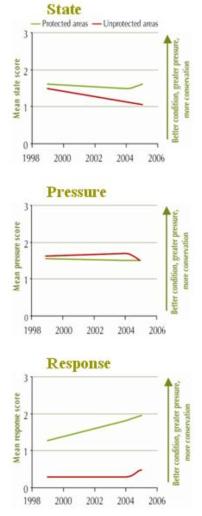
In Kenya, assessments from using BirdLife’s Important Bird Area (IBA) monitoring framework indicate that IBAs with formal protection are in better and more stable condition than those without. IBA indices also show that protected IBAs are subject to marginally lower pressures and have better conservation responses in place, including better management planning and implementation, than are non-protected sites.

Data from 1999–2005 covering 36 out of 60 of Kenya’s IBAs (see Bennun and Njoroge 1999, Otieno et al. 2005 and Musila et al. 2006) indicate that IBAs with formal protection (IUCN Categories I–VI including Forest Reserves and National Monuments) are in better condition on average than unprotected IBAs (Mwangi et al. 2010; monitoring methodology follows BirdLife International 2006). The condition of protected IBAs has remained more or less stable over this period, while that of non-protected IBAs has declined. IBA indices also show that protected IBAs have better conservation responses in place, including better management planning and implementation. For example, positive changes in forest legislation and policy strengthened management during 1999–2005, resulting in stricter controls on the use of natural resources at these IBAs and intensified patrols by both the Kenya Wildlife Service and Kenya Forest Service (Musila et al. 2006). In this case, IBA monitoring demonstrates the value of protected area legislation and designation for conserving biodiversity.
Related Case Studies in other sections
References
Compiled: 2008
Recommended Citation:
BirdLife International (2008)
In Kenya, IBA monitoring shows the value of formal protection for biodiversity conservation.
Downloaded from https://datazone.birdlife.org/sowb/casestudy/in-kenya-iba-monitoring-shows-the-value-of-formal-protection-for-biodiversity-conservation on 22/12/2024